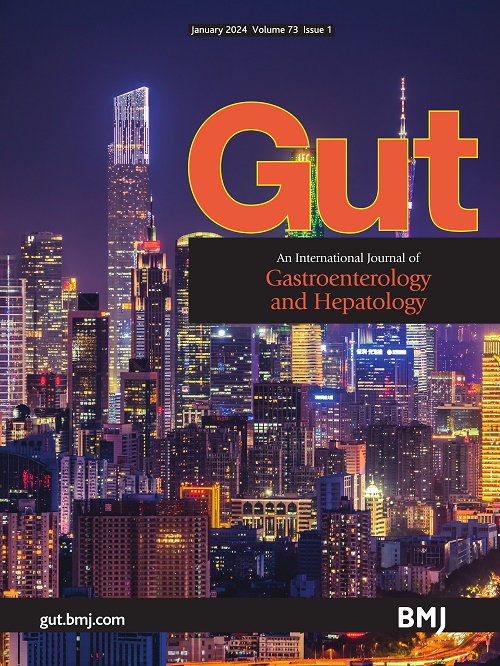肠拟杆菌通过色氨酸分解代谢物介导对伊立替康毒性的敏感性
IF 25.8
1区 医学
Q1 GASTROENTEROLOGY & HEPATOLOGY
引用次数: 0
摘要
背景迟发性腹泻仍然是临床伊立替康治疗管理不善的问题。虽然细菌β-葡萄糖醛酸酶(β-GUS)介导的SN-38产生被普遍认为介导肠道毒性,但β-GUS抑制剂在临床上的益处有限。目的探讨内源性细菌代谢物在伊立替康毒性易感性中的作用及机制。通过16S rRNA测序、霰弹枪宏基因组学和代谢组学研究伴有或不伴有腹泻的结直肠癌(CRC)患者的肠道微生物群和代谢物。通过代谢生物工程和肠道类器官培养研究了微生物代谢物在小鼠体内的作用。通过转录谱分析和化学干预研究了微生物代谢物对肠道干细胞的作用机制。结果伊立替康治疗后,腹泻和非腹泻患者的肠道微生物结构发生了不同程度的改变,易感性可通过移植基线粪便微生物组传递给受体小鼠。肠道拟杆菌(b.n testinalis)在腹泻易感人群和伊立替康治疗小鼠中明显扩大。大肠杆菌定殖使肠上皮对伊立替康诱导的化学损伤敏感,部分是通过色氨酸代谢物吲哚-3-醋酸酯(IAA)。大肠杆菌和产生IAA的生物工程菌均加重了伊立替康诱导的小鼠肠上皮损伤。在机制上,IAA抑制PI3K-Akt信号传导,从而损害伊立替康损伤下肠上皮的更新。在临床接受伊立替康治疗的患者中,粪便IAA水平与腹泻严重程度密切相关。结论我们的研究揭示了内源性细菌代谢物对伊立替康毒性易感性的形成机制,并提示IAA可能是一种潜在的预测性生物标志物。如有合理要求,可提供资料。本文章由计算机程序翻译,如有差异,请以英文原文为准。
Bacteroides intestinalis mediates the sensitivity to irinotecan toxicity via tryptophan catabolites
Background Late-onset diarrhoea remains a poorly managed concern for clinical irinotecan therapy. Although bacterial β-glucuronidases (β-GUS) mediated SN-38 production is prevailingly thought to mediate intestinal toxicity, β-GUS inhibitors confer limited benefits in the clinic. Objective This study aimed to explore the role and mechanism of endogenous bacterial metabolites in susceptibility to irinotecan toxicity. Design Gut microbiota profiles and metabolites in patients with colorectal cancer (CRC) with or without diarrhoea were investigated via 16S rRNA sequencing, shotgun metagenomics and metabolomics. The role of microbial metabolites was investigated in mice by metabolic bioengineering and intestinal organoid culture. The mechanism of microbial metabolites on intestinal stem cells was investigated by transcriptional profiling and chemical intervention. Results Gut microbial configuration was differentially remodelled in diarrhoea and non-diarrhoea patients with irinotecan therapy, and the susceptibility was transmissible to recipient mice via transplantation of baseline faecal microbiome. Bacteroides intestinalis ( B. intestinalis ) was notably expanded in the diarrhoea-prone cohorts as well as in irinotecan-treated mice. B. intestinalis colonisation sensitised intestinal epithelia to irinotecan-induced chemical injury, partially via tryptophan metabolite indole-3-acetate (IAA). Both B. intestinalis and bioengineered bacteria that produce IAA exacerbated irinotecan-induced intestinal epithelial injury in mice. Mechanistically, IAA suppressed PI3K-Akt signalling, thereby impairing the renewal of intestinal epithelia under the insult of irinotecan. In clinical patients receiving irinotecan therapy, faecal IAA level was closely associated with the diarrhoea severity. Conclusion Our study uncovers the mechanism of endogenous bacterial metabolite in shaping the individual susceptibility to irinotecan toxicity and suggests IAA as a potential predictive biomarker. Data are available upon reasonable request.
求助全文
通过发布文献求助,成功后即可免费获取论文全文。
去求助
来源期刊

Gut
医学-胃肠肝病学
CiteScore
45.70
自引率
2.40%
发文量
284
审稿时长
1.5 months
期刊介绍:
Gut is a renowned international journal specializing in gastroenterology and hepatology, known for its high-quality clinical research covering the alimentary tract, liver, biliary tree, and pancreas. It offers authoritative and current coverage across all aspects of gastroenterology and hepatology, featuring articles on emerging disease mechanisms and innovative diagnostic and therapeutic approaches authored by leading experts.
As the flagship journal of BMJ's gastroenterology portfolio, Gut is accompanied by two companion journals: Frontline Gastroenterology, focusing on education and practice-oriented papers, and BMJ Open Gastroenterology for open access original research.
 求助内容:
求助内容: 应助结果提醒方式:
应助结果提醒方式:


